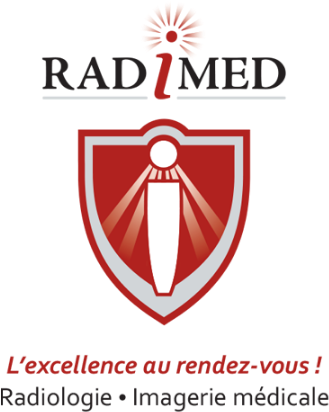Cardiac Imaging
Today, exams in cardiac imaging are more and more sophisticated, allowing for better diagnosis and helping to understand the condition of the patient.
Cardiac imaging uses many investigative techniques such as simple chest X-ray, coronary angiograph, echocardiography, etc.
With this technology, we can acquire images required for reliable and rapid diagnosis.
With decreased acquisition time combined with improved quality, this technology is increasingly used both in early screening and to facilitate precise evaluation of the structures and functions of the heart and valves.
Some of the services offered at RadiMed are:
- Echocardiography
- Coronary calcium scoring
- CT coronary angiogram.
Exam offered:
-
Calculation of the calcium score
The calculation of the calcium score or calcium scoring of the coronary arteries is a non-invasive method that seeks to quantify calcified plaque deposits in the coronary arteries. This examination uses a CT-scan coupled with ECG recording and sophisticated software to measure the amount of calcium accumulated in the patient’s coronary arteries.
The calculation of the calcium score does not require an injection of a dye. The calcium score is proportional to the size and density of the calcified plaques present in the coronary arteries. The higher the score, the higher the risk of suffering a significant heart attack leading to death. Information obtained by calculating the calcium score is added to the known patient risk factors, allowing the physician to target the type of treatment to minimize the risk of a heart attack.
The calculation of the calcium score not only detects the presence of calcified plaque in your coronary arteries, but also evaluates the amount (mild, moderate or severe) based on your age. Medical studies have already shown a direct correlation between the presence of calcified plaques in the coronary arteries and the risk of coronary heart disease, whether cardiac angina or myocardial infarction.
Note: A normal result in stress echocardiogram does not mean that you do not have atherosclerotic plaques in the coronary arteries.
Take 50 mg of the β-blocker Tenormin 4 hours before the examination, as prescribed by your physician.
Fast for four (4) hours before the examination. Avoid caffeine and smoking for twelve (12) hours before the examination. Do not exercise 24 hours before the examination.
-
Cardiac MRI
Fast 4 hours before the examination, no caffeine for 12 hours before.
-
Ct-Coronary Angiography Scan
CT Coronary Angiography is a medical imaging examination with computed tomography (CT-scan). It allows the visualisation of the blood vessels of the heart, called coronary arteries, after injection of iodinated contrast. This is a quick and painless examination.
The only contraindications to this examination are an allergy to iodine and kidney failure. This examination is done preferably by premedication with beta blockers to maintain a low and steady pulse, unless there are contraindications to taking beta blockers.
Coronary angiography remains the reference examination, essential to the diagnosis of possible coronary artery disease: it allows, in fact, highlighting the number, topography and severity of coronary stenosis (blockage or anomaly of the caliber of arteries and their narrowing).
In addition to detecting coronary stenosis or blockages, it allows verification of the permeability impermeability of bypasses and bridges/stents, and examination of coronary and heart anatomy. The role of coronary angiography is not necessary in the accurate assessment of the degree of severity of already known coronary artery disease, but rather in its ability to determine if a severe coronary artery blockage is present or not. It relates to the ability of this examination to eliminate, with virtual certainty, the presence of lesions in the coronary arteries of a patient. Thus, a negative test will reassure you on your risk of stroke in the short and medium term.
The duration of the examination is, in general, about thirty minutes during which the electrocardiogram and blood pressure are continuously monitored.
In conclusion, CT coronary angiography is currently the most efficient, non-invasive technique for exploration of the coronary arteries. This examination is becoming a routine exam that will gradually find its place among the various cardiac explorations.
Take 50 mg of the β-blocker Tenormin on the eve (evening) and 4 hours before the examination, as prescribed by your physician. Do not take cardiac stimulants 12 hours before the examination and do not smoke. Fast four (4) hours before the examination. Do not exercise 24 hours before the examination.
Do not take medications against erectile dysfunction (e.g.: Viagra, Cialis) at least 24 hours before the examination.
If you are a type 2 diabetic, do not take Glucophage or Metformin the morning before the examination.
-
Echocardiography
Radimed is proud to offer the service of echocardiography, under the supervision of cardiologists
Description
Cardiac Ultrasound (echocardiography) is a medical imaging examination that allows the study of the anatomy and functioning of the heart with the help of ultrasound. This is the basic examination to view and evaluate the various cardiac structures (heart muscle, valves, heart chambers, pericardium and great vessels).
Your doctor will recommend the exam if heart murmur is detected. The exam is also recommended to assess heart function and cardiac muscle (e.g. prior infarct). The exam allows visualizing that cardiac vessels function well. The pericardium can also be visualized, in order to see if water is present between the heart and its enclosure (pericardial effusion) or if inflammation (pericarditis) is present. The exam is also helpful to diagnose congenital defects (e.g. a hole in the heart).
Echocardiography is associated with the cardiac Doppler that allows the analysis of blood flow within the heart as well as the blood flow in the large vessels (aorta, vena cava, arteries and pulmonary veins).
Indications
- Evaluation of the heart muscle function as well as the size and volume of the heart chambers
- Evaluation of various valves looking for leaks or narrowing
- Evaluation of the pericardium (lining of the heart)
- Monitoring of valve prostheses
- Evaluation of congenital heart defects in adults
- Evaluation of the repercussion on the heart of various systemic diseases (lupus, scleroderma, hypothyroidism, sarcoidosis, neoplasia…)
Procedure
First the patient lies on the left side and then on the back on the examination table. The technician will attach sticky patches, and then the electrodes are connected to an echocardiography machine, which will provide us with an electrocardiogram at the same time as the heart images. The technician obtains different images of the heart as the probe scans different areas over the thorax. This exam presents no risks and it is painless. The cardiologist will then interpret the images. The referring doctor is responsible for the follow-up.
No preparation is necessary beforehand. You may eat and take your medication as usual.





